




Analysis of the evolution of the number of federation licenses in Spain (2009-2021)
Análisis de la evolución del número de licencias federativas en España (2009-2021)
Víctor Hernández-Beltrán, José M. Gamonales, Mário C. Espada, Adrián Escudero-Tena
Analysis of the evolution of the number of federation licenses in Spain (2009-2021)
Cultura, Ciencia y Deporte, vol. 18, no. 57, 2023
Universidad Católica San Antonio de Murcia
José M. Gamonales  * martingamonales@unex.es
* martingamonales@unex.es
Universidad de Extremadura, Extremadura, España
Universidad Francisco de Vitoria, Madrid, España
Instituto Politécnico de Setúbal, Portugal
Life Quality Research Centre, Portugal
CIPER - Faculdade de Motricidade Humana, Portugal
Received: 18 April 2023
Accepted: 10 july 2023
Abstract: Sport is defined as all physical activities aimed at improving physical fitness, developing social skills or acquiring positive achievements in competitions at another level. The celebration of the 1992 Olympic Games in Barcelona led to an increase in the number of federations licenses in Spain. Therefore, the aim of this study is to analyse and understand the evolution of the number of federation licenses in Spain according to the sport discipline, the sex of the participants and the sport clubs between 2009 and 2021. After performing a descriptive analysis of the data obtained, football is the sport with the highest number of licenses, followed by hunting, golf, climbing and basketball. In addition, padel is one of the disciplines that has shown the greatest growth in recent years. As for the sex of the sports participants, there is a notable difference between the number of male (75%) and female (25%) licenses. Lastly, in terms of sports clubs, football is the discipline with the highest number of clubs, followed by hunting, cycling, climbing and basketball. To reduce this gap, awareness-raising work regarding gender equality between men and woman should be carried out, as well as increasing knowledge of the existence of minority sports and sports for people with disabilities.
Keywords: Sports, autonomous community, sex, sport clubs.
Resumen: El deporte es definido como todo el conjunto de actividades físicas que tienen como finalidad la mejora de la condición física, el desarrollo de las habilidades sociales o la adquisición de logros positivos en competiciones de otro nivel. La celebración de los Juegos Olímpicos de 1992 en Barcelona supuso un aumento en el número de licencias federativas en España. Por ello, el objetivo del presente estudio es analizar y conocer la evolución del número de licencias federativas en España en función de la disciplina deportiva, el sexo de los participantes y los clubes deportivos entre los años 2009 y 2021. Tras la realización de un análisis descriptivo de los datos obtenidos, se observa como el fútbol es el deporte que presenta mayor número de licencias, seguido de la caza, el golf, la escalada y el baloncesto. Además, el pádel es una de las disciplinas que ha presentado un mayor auge en los últimos años. En cuanto al sexo de los deportistas, se observa una diferencia notable entre el número de licencias masculinas (75%), y femeninas (25%). Por último, en función de los clubes deportivos, el fútbol es la disciplina que presenta mayor número de clubes adscritos, seguido de la caza, el ciclismo, la escalada y el baloncesto. Para reducir esta diferencia se debe llevar a cabo un trabajo de concienciación en la igualdad entre hombres y mujeres, así como aumentar el conocimiento de la existencia de deportes minoritarios y deportes para personas con discapacidad.
Palabras clave: Deportes, comunidades autónomas, sexo, clubes deportivos.
Introduction
In recent years, the number of users practicing sports in Spain has increased (Gómez-Chacón et al., 2018) with around 53% (± 25 million people) of the Spanish population regularly involved in sports (Moscoso-Sánchez, 2020). The percentage of inactivity is higher in women (Gamonales et al., 2016; Luengo-Vaquero, 2007), despite a strong increase in women's physical activity (Piedra, 2019). Physical sports practice entails a series of health benefits that, together with healthy styles and habits, increase the quality of life of athletes (Romero-Casado et al., 2019; Torregrossa et al., 2019). Sport influences the social skills of athletes (Pelegrín et al., 2010). In the scientific literature, there are documents related to the motivation to practice physical activity and sports. Different motives lead people to exercise: dispositional, participatory, and regulatory (Torregrossa et al., 2019). The concept of sport has evolved greatly over the years, from its origins to the present day, it is understood as:
“All types of physical activities which, through organized participation or otherwise, aim at the expression or improvement of physical and mental fitness, the development of social relations, or the achievement of results in competitions at all levels” (Carta Europea del Deporte, 2021, p. 10).
Furthermore, within the concept of sport, minority physical-sports practices are identified, which are those sports modalities that are far removed from media sports such as football, basketball, motorcycling, padel, cycling, or even Formula 1, due to the arrival of Spanish sportsmen and women. As a result, the rest of the sporting disciplines are considered minority sports (Gómez Sánchez, 2021). In other words, minority sport is understood as the group of sporting modalities with a low population quota, and which, in addition, have a low number of federative licenses. Moreover, due to the pre-eminence of football alone in the media, it does not allow different modalities to be known, which are only known when great achievements are made by sportsmen and women (Rojas-Torrijo, 2012), because of sports marketing (Orfila & Moya-Mata, 2019). Most athletes dream of participating in the most important and applauded sporting events in history (Jensen et al., 2014; Rodríguez-Quijada & Molkova, 2016), such as the Olympic Games.
In Spain, the 1992 Barcelona Olympic Games brought about a change in world sports, and specifically in Spanish sports, as a result of the successes produced by Spanish sportsmen and women (López, 2017). Due to this boom, the number of federative licenses grew exponentially, increasing by 150% in 20 years (López, 2017), for example in the sports of hunting (Gamonales et al., 2016), or padel (Fernández-Martínez et al., 2018). This growth is also due to the influence of the great achievements of sportsmen and women in their different sports, or, on the contrary, to the scarce presence of Spanish sportsmen and women in certain disciplines (Gómez-Chacón et al., 2018). The same occurs regarding the sex of the athletes, since inequalities can be seen preventing equal development between men and women (Zapico-Robles & Tuero del Prado, 2014). Within Olympic sports, there has been an increase in the number of women participants, although it is still a very small percentage in relation to the total population, because of the lack of professional leagues, clubs, and other resources in recent years in elite and amateur sport, female athletes face difficult situations when looking for and finding a team. Therefore, they accept minority contracts to end up playing (Aliendre & Contreras, 2019; Giménez Pérez-Chuevos & Rodríguez-Ferran, 2021; Hijós, 2020). Consequently, the number of women in high performance remains small. Furthermore, due to the large number of benefits produced by physical sports practice, the incorporation of women into sports as a way of life should be encouraged. Likewise, regular physical activity has presented different benefits such as the reduction of the risk of suffering from cardiovascular diseases, type II diabetes (Courel-Ibáñez et al., 2017), and, the reduction of body weight (Chodzko-Zajko et al., 2009). Therefore, due to the large number of benefits obtained from the practice of physical activity, there has been an increase in the number of populations, producing a growth of interest in sports (García-Ferrando & Llopis, 2010).
Therefore, due to the scarcity of existing literature analysing the evolution of the number of federative licenses according to different factors (sport discipline, sex of the athletes, and sports clubs), this paper presents the following objectives: a) to analyse the evolution of the number of federative licenses according to the sports discipline; b) to know the number of federative licenses according to the sex of the athletes, and, c) to identify the sports clubs that have shown the greatest growth according to the year, autonomous community and sport modality.
Method
Design
The aim of this paper was to analyse the evolution of the number of licenses as a function of different factors such as sport discipline, sex of the athletes, year, and sports clubs. Empirical research has been carried out following a descriptive strategy (Ato et al., 2013). In addition, a process of defining and classifying the number of federations licenses according to different variables has been carried out.
Sample
The sample was drawn from the register of the number of sports clubs where a sport was practiced with a federation at the state level and at the autonomous community level in Spain from 2009 to 2021. This information is provided by the Consejo Superior de Deportes, Ministerio de Cultura y Deporte, Ministerio de España (2022).
Variables
For the present study, the number of sports licenses were selected as an independent variable. The dependent variables were selected as sport discipline, sex of participants, and sports clubs.
Statistical Analysis
Once the database was formed, a descriptive analysis (frequency and percentage) was carried out to obtain information on the evolution of the number of sports licenses. Finally, with these descriptive analyses of the data, different tables and figures were created using a Microsoft Excel 2016 spreadsheet for Windows.
Results
The results show that the sport with the highest number of sports licenses in Spain is football, although from 2017 to 2021 its number has decreased. On the other hand, the number of sports licenses for hunting, golf and basketball have decreased over the years, although if we compare the period 2017 to 2021, hunting and golf have slightly increased. In contrast, sport licenses in climbing have been increasing over all the years studied because of their incorporation in the Olympic Games (Figure 1).
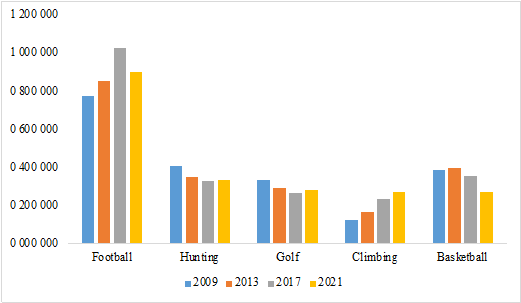
Figure 1.
Analysis of the five sports with the highest number of sport licenses in Spain from 2009 to 2021 (number and year)
Figure 2 shows the sixth to the 19th sport with the most sports licenses in Spain. Over the years, in 2021, padel has become the sixth sport with the most sports licenses in Spain. It is the sport that has grown the most in the years studied. Similarly, the number of sports licenses in athletics, volleyball, cycling, surfing, skating, swimming, and gymnastics have increased considerably from 2009 to 2021. However, the number of federation licenses for the remaining sports has remained the same, decreased, or suffered small rises and falls because of different factors such as the COVID-19 pandemic.
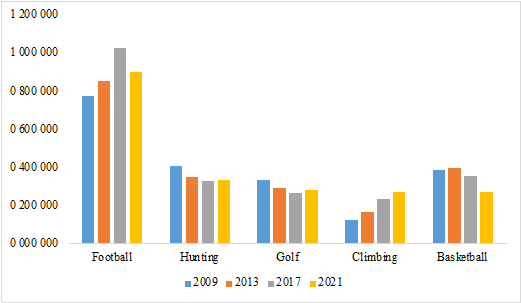
Figure 2.
Analysis of the sixth to 19th sport with the highest number of federative licenses in Spain from 2009 to 2021 (number and year)
Table 1 shows the number and percentage of sports licenses in Spain in 2021 by sport discipline. Sports such as football, hunting, golf, climbing, and basketball are the sports with the highest number of federative licenses in Spain, accounting for almost 60% of sports licenses. On the other hand, padel, handball, athletics, tennis, volleyball, cycling, horse riding, surfing, skating, swimming, judo, fishing, karate, and gymnastics have 1 008 879 sports licenses, as they have between 50 000 and 100 000 licenses in Spain. Finally, the rest of the sports with a federation in Spain have fewer than 20 000 sports licenses. As for the sex of federated sportsmen and sportswomen in Spain, 75% of federative licenses are held by men, while only 25% of sports licenses belong to women. Therefore, all sports modalities have a greater presence of men as federative representatives except gymnastics (93.47%), equestrian (72.44%), volleyball (68.87%), and skating (61.99%) in which women predominate. In contrast, the sports with the lowest number of female federations representatives are the sports disciplines of hunting (1.19%), fishing (6.72%), football (7.40%), and cycling (7.59%).
Analysis of sports licenses in Spain by sport discipline and gender (2021)
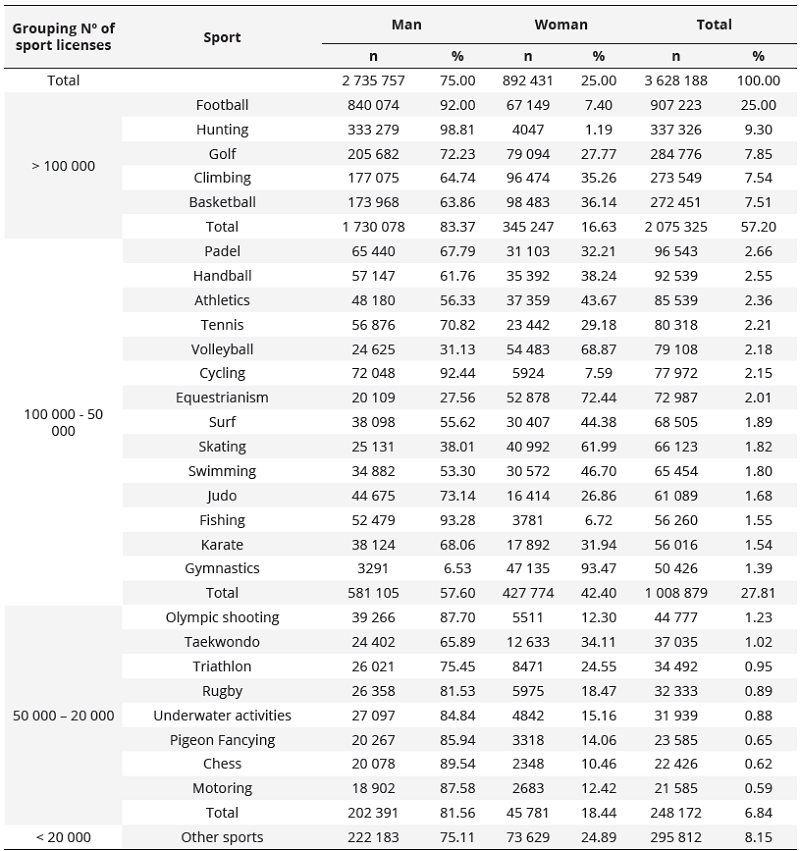
Figure 3 shows the evolution of the number of federation licenses over the years in Spain. In addition, it can be seen how the number of federation members has been increasing, although there was a relapse in the years 2014, 2020 and 2021.
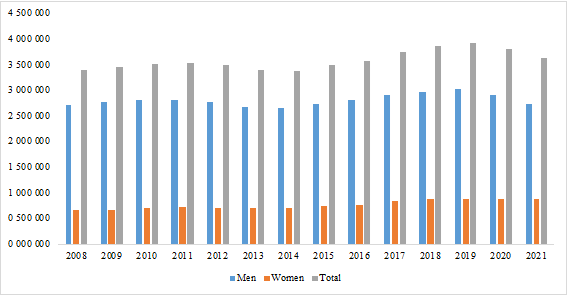
Figure 3.
Analysis of the number of federative licenses in Spain according to sex from 2009 to 2021 (number and year)
Finally, Table 2 shows the number and percentage of sports licenses in Spain by autonomous community in 2021. It also shows the five sports with the highest number of sports licenses per autonomous community and the percentage of members according to the number of inhabitants. The autonomous communities of Catalonia, Andalusia, and Madrid are the regions with the highest number of members in Spain. In contrast, Ceuta and Melilla are the autonomous communities with the lowest number of federated sportsmen and women. However, the percentage of federated athletes according to the number of inhabitants per autonomous community shows that the autonomous community of Melilla (12.49%), Navarre (12.00%), and Cantabria (11.44%) are the regions with the highest percentage of federated athletes. On the other hand, Castilla-La Mancha (5.18%) is the autonomous community with the lowest number of federated sportsmen and sportswomen in terms of population, and football is the sport with the highest number of federated licenses in all the autonomous communities, except for the regions of Extremadura and La Rioja, since hunting as a physical-sports practice is the sport with the highest number of federated sportsmen and sportswomen. Furthermore, hunting, golf, climbing, and basketball tend to be among the five sports disciplines with the highest number of sports licenses per Autonomous Community. Finally, less frequently, fishing, surfing, surfing, triathlon, volleyball, tennis, padel, judo, Pigeon Fancying, weightlifting, handball, and athletics are among the five sports with the highest number of licenses in some autonomous communities. Thus, for example, Pigeon Fancying appears in Murcia, padel in Navarre, surfing in the Canary Islands, Galicia, and Cantabria, volleyball in Extremadura and Melilla, fishing in Asturias, judo in Madrid, handball in Castilla-La Mancha and triathlon in Ceuta. Regarding the sex of the athletes, the autonomous communities with the highest female representation are the regions of Navarre and the Balearic Islands. However, Extremadura is the autonomous community with the lowest number of female athletes with federative licenses.
Analysis of sports licenses in Spain by autonomous community (year 2021)
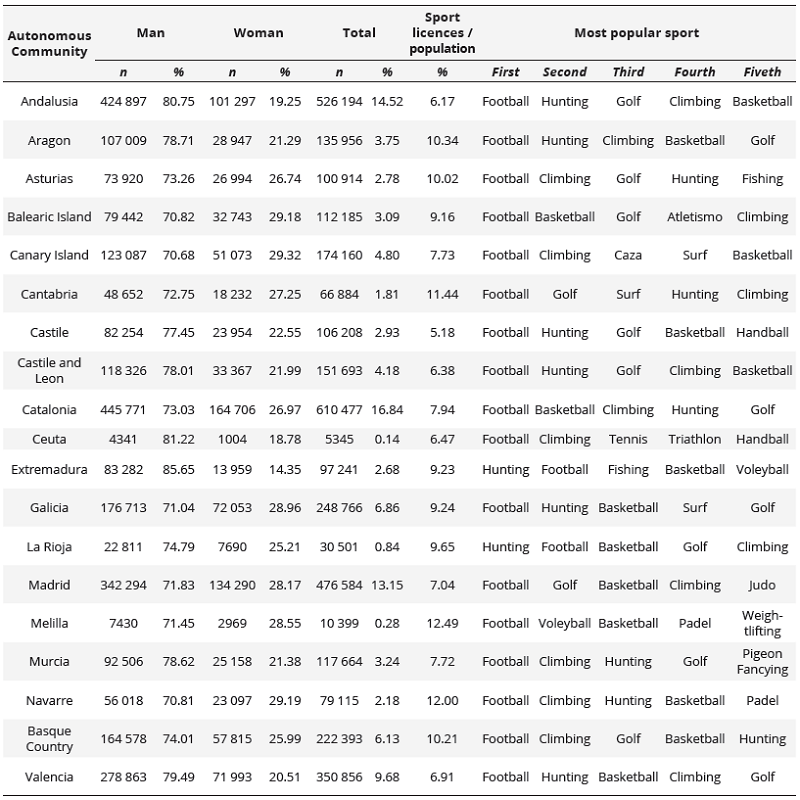
On the other hand, the results show that the sport with the highest number of clubs dedicated to its practice and development is football. Also, it can be observed that their number from 2017 to 2021 has increased significantly (opening about 10 000 football clubs). In addition, the number of hunting, cycling, and climbing sports clubs, although to a lesser extent than football, has increased. In contrast, sports clubs dedicated to basketball have been disappearing in recent years (Figure 4).

Figure 4.
Analysis of the five sports with the largest number of clubs dedicated to their practice in Spain (number and year)
Figure 5 shows the sixth to the 14th sport with the highest number of clubs in Spain. Over the years, in 2021, skating is the sixth sport with the highest number of clubs dedicated to its development. Similarly, the number of clubs where padel, motorcycling, triathlon, and gymnastics are practiced has increased considerably from 2009 to 2021. However, the number of sports centers dedicated to the rest of the sports included in Figure 3 has remained the same, decreased, or gone up and down. Finally, athletics, although its number of clubs has increased from 2009 to 2021, many sports complexes closed from 2017 to 2021.
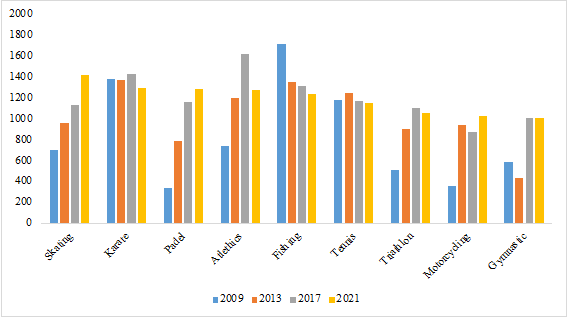
Figure 5.
Analysis of the sixth to 14th sport with the largest number of clubs in Spain (number and year)
Table 3 shows the number and percentage of clubs in Spain in 2021 according to the sport practiced. Thus, football, hunting, cycling, climbing, and basketball are the sports disciplines with the highest number of clubs dedicated to their practice, representing more than 60% of the sports clubs in Spain. On the other hand, skating, karate, padel, athletics, fishing, tennis, triathlon, motorcycling, and gymnastics have 10 762 clubs, as they have between 1000 and 2000 clubs dedicated to their development. Finally, the rest of the sports with a federation in Spain have fewer than 1000 sports centers where they are practiced.
Analysis of sports clubs in Spain according to sporting discipline (year 2021)
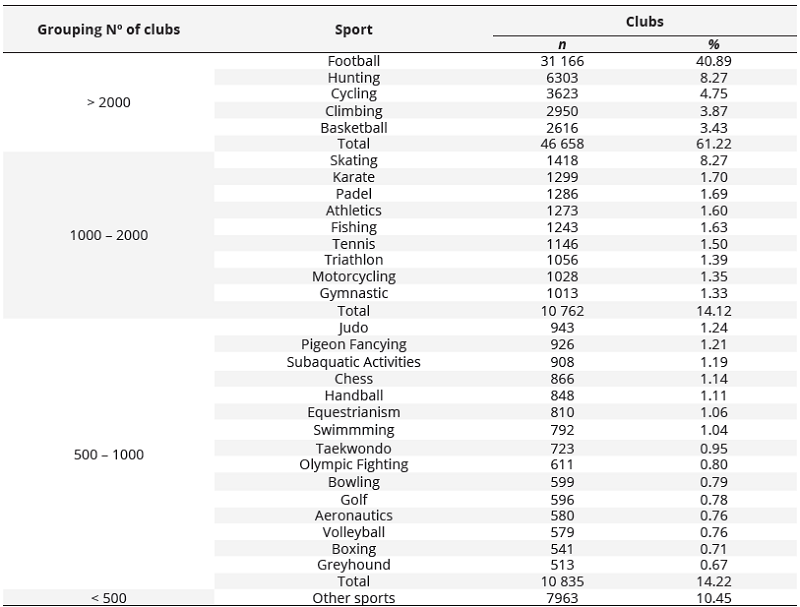
Finally, Table 4 shows the number and percentage of clubs in Spain by autonomous community in 2021. It can be seen which are the five sports with the highest number of sports centers dedicated to their practice by the autonomous community. The first region is Andalusia, followed by Catalonia, the autonomous communities with the highest number of sports complexes in Spain. On the other hand, the autonomous communities of Ceuta and Melilla are the regions with the lowest number of clubs. On the other hand, football is the sport with the highest number of clubs in all the autonomous communities. In addition, hunting, cycling, climbing, and basketball tend to be among the five sports with the highest number of clubs per autonomous community. Finally, with less frequency, fishing, skating, underwater activities, bowling, tennis, padel, judo, pigeon fancying, karate, athletics, and pétanque are among the five sports with the highest number of clubs in any autonomous community. Thus, for example, Pigeon Fancying appears in the regions of Murcia and Valencia, karate in the autonomous community of Madrid, bowling in the region of Cantabria, underwater activities in the autonomous communities of Melilla and the Canary Islands, fishing in the regions of Melilla and Andalusia and/or skating in the autonomous community of Asturias.
Analysis of sports clubs in Spain by Autonomous Community (year 2021)
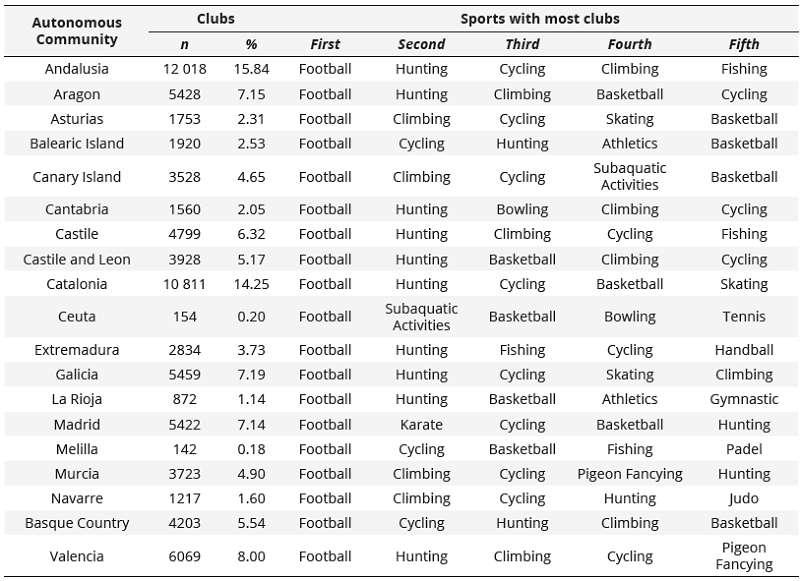
Discussion
The first objective of this study was to analyse the evolution of the number of federative licenses according to sporting discipline. Subsequently, we analysed the number of federative licenses according to the sex of the athletes, as this could be a point of information for designing and planning new programs for the incorporation of high-performance athletes. Finally, the aim was to identify the sports clubs that have shown the greatest growth in terms of year, autonomous community, and sporting modality, to find out the sporting trends of Spanish federated users. The results show that the sport with the highest number of federated licenses in Spain is football from 2009 to 2021. However, it has suffered a decrease in federative cards in the period from 2017 to 2021, as well as in basketball, and as has happened in major sporting events such as the Extremadura Gymnastrada because of the COVID-19 (Gamonales et al., 2022). On the other hand, the next sports modalities with the highest number of federative licenses are hunting, golf, climbing, and basketball. Furthermore, the number of federative licenses in Spain varies depending on the autonomous community, since there are regions such as Extremadura and La Rioja that have a greater number of federative licenses for the physical sports practice of hunting than for the sport of football. Furthermore, the autonomous communities with the highest representation of female federation licenses are the regions of Navarre and the Balearic Islands. In the scientific literature, papers related to the number of sports licenses are scarce and focused on analysing and describing specific sports such as padel (Courel-Ibáñez et al., 2017; Gómez-Chacón et al., 2018). Therefore, because of the results obtained, and the scarce documents related to the subject under study, it is necessary to continue researching, since this study can serve as a fundamental tool to understand the sporting trends of Spanish federated practitioners and to propose sports programs in those autonomous regions where the number of female federative licenses is lower, as is the case in Extremadura.
Considering the results related to the sports modalities that have the highest number of licenses in Spain according to sporting discipline, football, hunting, golf, climbing, and basketball standout. Subsequently, from the sixth to the nineteenth sport with the highest number of sports licenses, padel, handball, athletics, tennis, volleyball, cycling, horse riding, surfing, skating, swimming, judo, fishing, karate, and, gymnastics have been exchanging positions according to the year. In the scientific literature, there are no documents that corroborate the results obtained in this study. However, there are studies related to federal licenses in padel. Being a sport discipline that is booming due to the ease of practice and the options of facilities - outdoor/indoor (Courel-Ibáñez et al., 2017; Gómez-Chacón et al., 2018). Therefore, it is recommended that politicians and other staff involved in planning programs for the design and implementation of accessible sports facilities for all people regardless of their motor skills, since in the period from 2009 to 2021, no sport for people with disabilities appears. In this way, equal opportunities will be given to all people who want to carry out any type of physical-sporting activity.
About the number of sports licenses in Spain according to the sex of the sportsperson, 75% of sportsmen and women hold federation licenses, while only 25% of sports licenses belong to women. On the other hand, the sports disciplines with the lowest number of female athletes are hunting (1.19%), fishing (6.72%), football (7.40%) and cycling (7.59%). In the scientific literature, there are no documents related to the analysis of the number of sports licenses in Spain according to sex that corroborate the results obtained. However, there are studies related to the sex of athletes in specific disciplines such as goalball (Muñoz-Jiménez et al., 2021), basketball (Duque et al., 2022), padel (Escudero-Tena et al., 2021; Escudero-Tena et al., 2022; Muñoz et al., 2022), or handball (Da Silva-Musca et al., 2022), among others. Likewise, the results obtained may be influenced by different factors that condition their practice, such as culture, socioeconomic status (federal licenses decreased between 2011-2013), public health reasons (federal licenses have decreased between 2019-2021 - COVID-19), and politics. Therefore, this study is the first document that provides a general analysis of sportsmen and sportswomen in Spain according to gender and provides insight into sporting trends. In addition, it allows for the establishment of sports diagnoses with the aim of increasing the number of participants in specific disciplines because of having a reduced number of sports licenses. Furthermore, for future work related to the subject, it would be advisable to analyse the age at which sports are abandoned in all disciplines in Spain to establish strategies to avoid early abandonment, given that, for example, 80% of young sportsmen and women stop physical-sporting activity after the age of 15 (Vlachopoulos & Gigoudi, 2008).
The results related to the number of clubs in Spain according to sport discipline and autonomous community show that football, hunting, cycling, climbing, and basketball are the sports with the most teams dedicated to their practice in Spain (60% of sports clubs). The autonomous communities of Andalusia and Catalonia have the highest number of sports teams. On the other hand, the regions with the lowest number of sports clubs are Ceuta and Melilla. The studies related to sports in the Autonomous Communities are specific to regions such as Madrid or Valencia. That is to say, there are no documents that analyse sports disciplines in general in all the autonomous communities of Spain, and even the existing studies are focused on the knowledge of the supply of sports facilities (Burillo et al., 2010; Campos et al., 2007; Molina-García & Castillo, 2009). Therefore, this study is important because it allows us to know where most of the teams with the highest number of federations licenses are located. Therefore, it allows us to plan sports strategies with the aim of encouraging autonomous communities with the lowest number of sports clubs.
Conclusions
The sport discipline with the highest number of federative licenses in general in Spain is football from 2009 to 2021. However, in specific autonomous communities, such as Extremadura and La Rioja, the physical-sports practice of hunting has a higher number of federative licenses than football. Furthermore, the autonomous communities with the highest representation of female federation licenses are the regions of Navarre and the Balearic Islands. Women have the lowest number of licenses in the sports disciplines of hunting, fishing, football, and cycling. For this reason, the present study is fundamental in order to know the physical-sports tendencies of federated practitioners. Furthermore, the data obtained may be influenced by culture, socioeconomic level, public health reasons (COVID-19), and politics, which must be considered when planning and analysing the sports offer.
Regarding the sex of the practitioners, it should be mentioned that there is great inequality in terms of the number of federative licenses. Men are the ones who practice the greatest number of federated sports. For this reason, a process of change towards equal opportunities between men and women in the sporting and social sphere must be carried out. In the same way, there should be an increase in awareness of sports considered to be minority sports, and to make them known to the population with the aim of increasing the number of practitioners, since sports should be considered a tool that promotes healthy lifestyle habits, and, allowing the elimination of stereotypes and harmful attitudes, which hinder the development of people in society, as well as their expectations and possibilities of action.
Finally, among the sports that appear with a greater or lesser number of federative licenses, there is no sport for people with disabilities. Therefore, conventional, adapted, and specific sports for people with disabilities should be promoted, given that there is a diversity of competitions at local, regional, and national levels in Spain, and even at the international level, such as the Paralympic Games.
Limitations
The main objective of this study was to determine the evolution of the number of federations licenses according to sex, autonomous community, and sports clubs. Therefore, one of the main limitations was the scarcity of existing literature on studies that analyse the evolution of the number of licenses in different disciplines in Spain. Therefore, it is recommended to continue in the same line of research, since the knowledge generated in this study allows us to know the trends in federated sports by autonomous community.
Practice Applications
Establish new measures in the regulations of sporting disciplines to favor equality between men and women. In addition, knowledge programs should be carried out on the different sporting modalities existing in educational centers, with the aim of increasing the number of sportsmen and women for each of the sporting disciplines. In the same way, different attitudes and values can be encouraged through sports practice in the training categories with the aim of acquiring positive attitudes towards equality between men and women, and acceptance and inclusion of people with disabilities.
Author contributions
VH-B and JMG prepared the Introduction and Method. MCE and AE-T developed the results in depth and revised the paper in its entirety. VH-B, JMG, and MCE prepared the Discussion and Conclusions. Finally, VH-B, JMG, MCE, and AE-T proceeded to review the document in its entirety.
Acknowledgments
This study was developed within the Group of Optimization of Training and Sports Performance (GOERD), Faculty of Sports Sciences, University of Extremadura, Cáceres (Spain), and in collaboration with Francisco de Vitoria University, Madrid (Spain).
Funding
This study has been partially funded by the Aid to Research Groups (GR21149), of the Regional Government of Extremadura (Regional Ministry of Employment and Infrastructures); with the contribution of the European Union through the European Regional Development Funds (ERDF). The author Mario C. Espada is the beneficiary of a grant (Grant Ref.: UIDB/04748/2020), from the Foundation for Science and Technology (FCT-IP) and supported by the Instituto Politécnico de Setúbal. In addition, the author José M. Gamonales is the beneficiary of a grant from the Spanish University System Upgrading Programme, Field of Knowledge: Biomedical (Grant Ref.: MS-18).
Conflict of interest
The authors do not indicate any conflict of interest. Furthermore, it should be noted that none of the authors have contributed to the evaluation of the selected papers. Likewise, the scores have not been contaminated by the authors of the paper.
Bibliography
Aliendre, C.R., & Contrera, M. (2019). La discriminación de género en el deporte. El caso del fútbol femenino. SCIENTIAMERICANA: Revista Multidisciplinaria, 6(2), 81-90. https://revistacientifica.uamericana.edu.py/index.php/scientiamericana/article/view/295
Ato, M., López-García, J.J., & Benavente, A. (2013). A classification system for research designs in psychology. Annals of Psychology, 29(3), 1038–1059. https://doi.org/10.6018/analesps.29.3.178511
Bravo-Chaucanes, J.D., Delgado-Delgado, I.A., Lagos-Erazo, C.D., & Paz-Benavides, J.D. (2022). Los Juegos Recreativos en el Fútbol como Estrategia para Promover la Inclusión de Género. Lúdica Pedagógica, 1(35), 1-18. https://revistas.pedagogica.edu.co/index.php/LP/article/view/14550
Burillo, P., Rodríguez-Romo, G., Salinero, J.J., Gallardo, L., & Tascón, M.G. (2010). La distribución territorial de la oferta de instalaciones deportivas en España. Clasificación de las Comunidades Autónomas en función del ISID. Apunts: Educación Física y Deportes, (100), 56-65. https://revista-apunts.com/la-distribucion-territorial-de-la-oferta-de-instalaciones-deportivas-en-espana-clasificacion-de-las-comunidades-autonomas-en-funcion-del-isid/
Campos, A., Martínez, J., Mestre, J., & Allella, C. (2007). Los profesionales de la organización y gestión de actividad física y deporte en las instalaciones deportivas y entidades: características socio-demográficas y formativas. RICYDE: Revista Internacional de Ciencias del Deporte, 3(8), 25-38. https://www.redalyc.org/pdf/710/71030803.pdf
Carta Europea del Deporte (2021). Consejo de Europa. pp. 1-26. Recuperado el 18 de Diciembre de 2022 de https://www.consejo-colef.es/post/carta-europea-del-deporte-2021
Chodzko-Zajko, W.J., Proctor, D.N., Fiatarone Singh, M.A., Minson, C.T., Nigg, C.R., Salem, G.J., & Skinner, J.S. (2009). Exercise and physical activity for older adults. Medicine and Science in Sports and Exercise, 41(7), 1510-1530. http://www.eurohex.eu/bibliography/pdf/ChodzkoZajko_2009-0750239745/ChodzkoZajko_2009.pdf
Courel-Ibáñez, J., Sánchez-Alcaraz, B.J., García-Benítez, S., & Echeregay, M. (2017). Evolution of padel in Spain according to practitioners’ gender and age. Cultura, Ciencia y Deporte, 12(34), 39–46. https://doi.org/10.12800/ccd.v12i34.830
Consejo Superior de Deportes - CSD. (2022). Consejo Superior de Deportes. Recuperado el 18 de Diciembre de 2022 de https://www.csd.gob.es/es/federaciones-y-asociaciones/federaciones-deportivas-espanolas/licencias
Da Silva-Musca, V., De Senzi-Barreira, C.P., Pombo-Meneces, R., Gonçalves-Madeira, M., & Pereira-Morato, M. (2022). Self-organization in male and female high level handball. E-balonmano.com, 18(3), 193-199. https://dehesa.unex.es/bitstream/10662/16550/1/1885-7019_18_3_193.pdf
Duque, V.H., Mancha-Triguero, D., Ibáñez, S.J., & Sáenz-López, P. (2022). Motivación, inteligencia emocional y carga de entrenamiento en función del género y categoría en baloncesto en edades escolares. Cuadernos de Psicología del Deporte, 22(2), 15–32. https://doi.org/10.6018/cpd.450341
Escudero-Tena, A., Courel-Ibáñez, J., García-Rubio, J., & Ibáñez, S.J. (2021). Sex differences in professional padel players: Analysis across four seasons. International Journal of Performance Analysis in Sport, 21(5), 651-662. https://doi.org/10.1080/24748668.2021.1930363
Escudero-Tena, A., Muñoz, D., Sánchez-Alcaraz, B.J., García-Rubio, J., & Ibáñez, S. J. (2022). Analysis of errors and winners in men’s and women’s professional padel. Applied Sciences, 12(16), 8125. https://doi.org/10.3390/app12168125
Fasting, K., Seraton, S., Pfister, P., Vázquez, B., & Buñuel, A. (2000). Experiencia y significado de la educación física en la vida de las mujeres de algunos países europeos. Instituto de la mujer.
Fernández-Martínez, N., Gómez-Chacón, R., Bernal-García, B., & Pérez-Villalba, M. (2018). Evolución de las licencias federativas de pádel en categoría absoluta en Andalucía (2009-2016). In J. García-Fernández, M. Valcarce-Torrente, & V. Javaloyes-Sanchís (Eds.), Sport Business Symposium. Sport and Business,a Successful Relationship (pp. 37–41). Wanceulen.
Gamonales, J.M., León, K., & Muñoz-Jiménez, J. (2016). Condición física y hábitos de práctica físico-deportiva de los cazadores extremeños. E-Balonmano.com: Revista de Ciencias del Deporte, 12(3), 207-222. https://dehesa.unex.es/bitstream/10662/6786/1/1885-7019_12_3_207.pdf
Gamonales, J.M., León, K., & Muñoz-Jiménez, J. (2022). ¿Influye la pandemia del COVID-19 en las redes sociales de eventos no competitivos en edad escolar y adulta? Estudio de caso. MHSalud: Revista en Ciencias del Movimiento Humano y Salud, 19(2), 1-13. https://doi.org/10.15359/mhs.19-2.9
García-Ferrando, M., & Llopis, R. (2010). Ideal democrático y bienestar personal. Los hábitos deportivos en España 2010. Consejo Superior de Deportes y Centro de Investigaciones Sociológicas.
Giménez Pérez-Chuecos, M., & Rodríguez-Ferran, O. (2021). Análisis de la presencia de la mujer en el fútbol y fútbol sala de la CARM desde 2010 hasta la actualidad. E-Motion: Revista de Educación, Motricidad e Investigación, (17), 85-102. https://doi.org/10.33776/remo.vi17.5138
Giner, G.O., & Moya-Mata, I. (2019). ¿Es la prensa deportiva un factor influyente en la elección de referentes y de prácticas deportivas de los alumnos de primaria? Actividad Física y Deporte: Ciencia y Profesión, (30), 56-57. https://dialnet.unirioja.es/servlet/articulo?codigo=7177683
Gómez-Chacón, R., Pascua-Barón, D., & Fernández-Martínez, N. (2018). Evolución de las licencias federativas (1994 - 2016). Pádel vs. Tenis. Materiales para la Historia del Deporte, 16, 43–49. http://polired.upm.es/index.php/materiales_historia_deporte/article/view/4082/4138
Gómez-Sánchez, A. (2021). Reportaje multimedia sobre el tratamiento mediático de los deportes minoritarios a nivel nacional. Auge, evolución y tratamiento mediático. Universidad de Valladolid.
Hijós, N. (2020). Todos los cuerpos, una misma cancha. Gambeteando la hegemonía masculina desde un fútbol femenino y disidente. Bordes: Revista de Política, Derecho y Sociedad, 15, 241-249. https://publicaciones.unpaz.edu.ar/OJS/index.php/bordes/article/view/624/575
Jensen, R.D., Christiansen, A.V., & Henriksen, K. (2014). The Olympic Games: The Experience of a Lifetime or Simply the Most Important Competition of an Athletic Career? Physical Culture & Sport, 64(1), 41-52. https://doi.org/10.2478/pcssr-2014-0026
López, P. (2017). Del fútbol al pádel: ¿Qué deportes han crecido más en federados desde Barcelona 1992? Palco23. Recuperado el 18 de Diciembre de 2022 de http://www.palco23.com/entorno/del-futbol-al-padel-que-deportes-han-crecido-mas-en-federados-desde-barcelona-1992
Luengo-Vaquero, C. (2007). Actividad físico-deportiva extraescolar en alumnos de primaria. Revista Internacional de Medicina y Ciencias de la Actividad Física y el Deporte, 7(27), 174-184. https://www.redalyc.org/pdf/542/54222960001.pdf
Moscoso-Sánchez, D. (2020). El contexto del deporte en España durante la crisis sanitaria de la COVID-19. Sociología del Deporte, 1(1), 15-19. http://doi.org/10.46661/socioldeporte.5000
Molina-García, J., & Castillo, I. (2009). Pensamiento sobre la gestión deportiva pública: un estudio cualitativo con universitarios valencianos. Actividad Física y Deporte: Ciencia y Profesión, 10, 13-24. https://dialnet.unirioja.es/servlet/articulo?codigo=3158953
Muñoz, D., Toro-Román, V., Vergara, I., Romero, A., Fernández de Ossó Fuente, A.I., & Sánchez-Alcaraz, B.J. (2022). Análisis del punto de oro y su relación con el rendimiento en jugadores profesionales de pádel masculino y femenino. Retos: Nuevas tendencias en Educación Física, Deportes y Recreación, (45), 275–281. https://doi.org/10.47197/retos.v45i0.92388
Pelegrín, A., Garcés, E., & Cantón, E. (2010). Estudio de conductas prosociales y antisociales. Comparación entre niños y adolescentes que practican y no practica deporte. Información psicológica, (99), 64-78. https://dialnet.unirioja.es/servlet/articulo?codigo=3641601
Piedra, J. (2019). La perspectiva de género en sociología del deporte en España: presente y futuro. Revista Española de Sociología, 28(3), 489-500. http://dx.doi.org/10.22325/fes/res.2019.13
Rodríguez-Quijada, M., & Molkova, S. (2016). Medallistas españoles en los Juegos Olimpicos de verano (1896-2012). EmásF: Revista Digital de Educación Física, 7(40), 79-86. https://dialnet.unirioja.es/servlet/articulo?codigo=5456615
Rojas-Torrijo, J.L. (2012). La futbolización de la información deportiva. Un estudio de casos de cuatro diarios deportivos europeos. Comunicação & Cultura, (13), 77–95. https://doi.org/10.34632/comunicacaoecultura.2012.629
Romero-Casado, A., Castro, R., Calderón, C.M., & Zagalaz, M. (2019). Beneficios de la práctica deportiva en la vida y en la escuela. Revista Observatorio del Deporte, 5(1), 61-79. https://www.revistaobservatoriodeldeporte.cl/index.php/odep/article/view/24
Torregrossa, M., Conde, E., Pérez, A., Ramis, Y., & Soriano, G. (2019). La actividad física y el deporte saludable en exdeportistas de élite. Cuadernos de Psicología del Deporte, 19(2), 12–27. https://doi.org/10.6018/cpd.350791
Vlachopoulos, S., & Gigoudi, M. (2008). Why Don't You Exercise? Development of the Amotivation Toward Exercise Scale Among Older Inactive Individuals. Journal of Aging & Physical Activity, 16(3), 316-341. https://doi.org/10.1123/japa.16.3.316
Zapico-Robles, B., & Tuero del Prado, C. (2014). Evolución histórica y educativa del deporte femenino. Una forma de exclusión social y cultural. Cuestiones de Género: de la Igualdad y la Diferencia, (9), 216–232. https://doi.org/10.18002/cg.v0i9.1230
Author notes
*Correspondence: José M. Gamonales, martingamonales@unex.es / josemartin.gamonales@ufv.es
Additional information
Short title: Evolution of the federative licenses in Spain
How to cite this article: Hernández-Beltrán, V., Gamonales, J.M., Espada, M.C., & Escudero-Tena, A. (2023). Analysis of the evolution of the number of federation licenses in Spain (2009-2021). Cultura, Ciencia y Deporte, 18(57), 173-196. https://doi.org/10.12800/ccd.v18i57.2041

ISSN: 1696-5043
Vol. 18
Num. 57
Año. 2023
Analysis of the evolution of the number of federation licenses in Spain (2009-2021)
VíctorJosé M.Mário C.Adrián Hernández-BeltránGamonalesEspadaEscudero-Tena
Universidad de ExtremaduraUniversidad Francisco de Vitoria Instituto Politécnico de SetúbalLife Quality Research CentreCIPER - Faculdade de Motricidade Humana,EspañaEspañaPortugalPortugalPortugal


